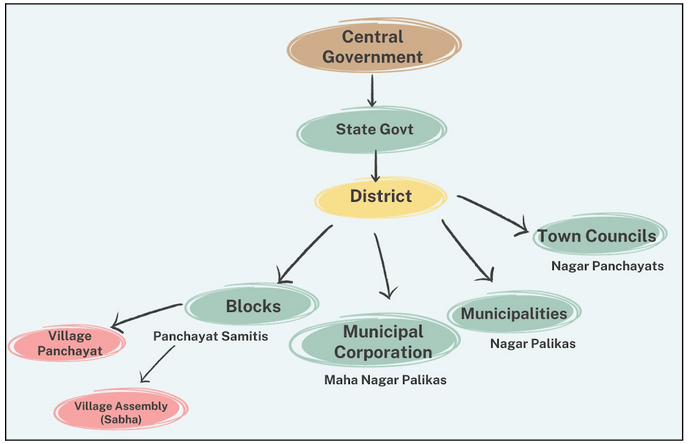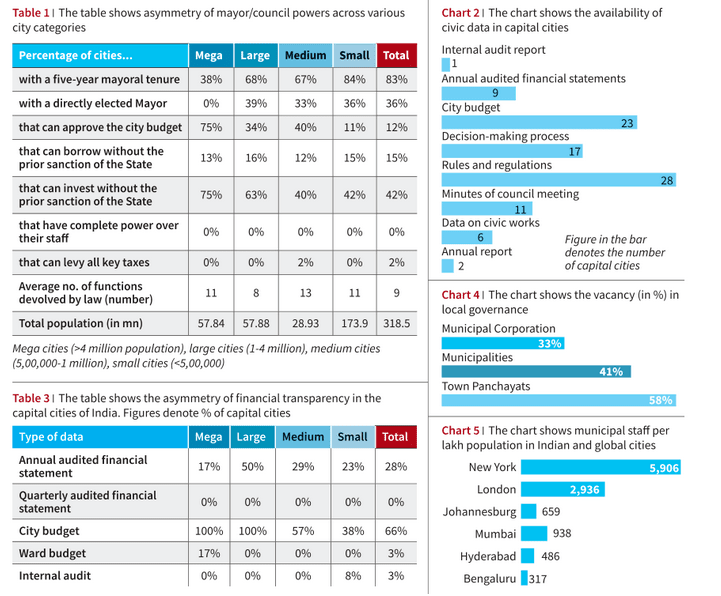Staff Shortage and Financial dependency plague local governance
| “Local self-government…. is the life-blood of Liberty”. - John Motley |
Relevance: GS II (Polity and Governance)
- For Prelims: Local Governments, 73rd Constitutional Amendment, 74th Amendment Act (1992)
- For Mains: Panchayati Raj Institutions, Urban Local Bodies.
News Excerpt:
An annual survey of Indian cities shows that most local governments depend financially on their State governments.
Evolution of Local Self-government in India:
Self-governing village communities have always existed in India since the earliest of times, as mentioned below:
- The first Municipal Corporation was set up in the former Presidency Town of Madras in 1688 and was followed by similar corporations in Bombay and Calcutta in 1726.
- Elected local self-government bodies came into existence after 1882, when Lord Rippon, took the initiative to create these bodies. At that time, these were known as local boards.
- Slowly, over a period of time, these village bodies were converted to form Panchayats.
- After the Government of India Act in 1919, village panchayats were firmly established in several provinces. While Lord Rippon is widely known as the father of local self-government, Mahatma Gandhi is also regarded as a key player in decentralizing political and economic power at the grassroots levels.
- Gandhi supported the strengthening of village panchayats and ensured the involvement of local self-governments in all developmental initiative
| Panchayats, or Panchayati Raj, is one of India’s oldest local self-government systems. The word ‘Panchayat’ means an assembly (ayat) or five (panch) people who rule (raj). |
- With the passing of the 73rd and 74th Constitutional amendments, it became mandatory for every state to have rural and urban local self-governments in place and the mechanisms to fund these bodies. It also became compulsory that these bodies carry out elections every five years.
- With the creation of this local governance, rural and urban local bodies were given the constitutional status that ensured uniformity in their functioning and structure across India.
- At present, there are over 250,000 local self-government bodies across the country, with over 3.1 million elected representatives. Out of this, 1.3 million representatives are women.

| Functions of Local Self-Government:The primary goal of the local bodies is to promote an environment for local economic development, social justice, and infrastructure development. The various functions of the local bodies include:
|
What is the significance of Local Self-Governance?
- Addressing grassroots problems: Public issues are majorly solved at the ground level by local governance only where the local self-government is responsible for various necessities such as infrastructure and maintenance, water availability, educational demands, hospitality, etc.
- People’s say is a priority: In local self-government, the people have more decision-making power over their problems. The representatives are directly elected from among the same community who know the issues for that particular region.
FROM THE EDITORIAL:The Annual Survey of India’s City - Systems (ASICS) 2023, was published by the ‘Janaagraha Centre’ for Citizenship and Democracy, a non-profit institution.Key Findings from the Report:
|
Way Forward:
- Maintaining a balance between Decentralization and Centralization: The most efficient local bodies of the world emphasized in providing information about their management. Governments that work harder to achieve more efficient management need to involve their citizens and other stakeholders in their good governance.
- Enhancing Transparency: Financial transparency is key in building trust in government among the citizens and courting their willingness to pay their taxes and other levies which in turn maximizes the authority’s budget. The local government should therefore pay attention to the preparation, presentation, and dissemination of quality financial information to the citizens in a timely and engaging manner.
- Need to hire skilled human resources: Strategic HR practices enable further insights into the linkage of institutional pressures, training, and development programs at regular intervals, by considering the inherent issues according to the associated region.
- Need for local capacity instead of concentrated authority: Gram Panchayat Acts in many States have empowered district-level bureaucrats, to act against local representatives for official misconduct. This kind of power leaves political interference against the development of the particular region.
- Need for reducing Asymmetry in decision making: As the power characterizes all forms of actions, asymmetric power relations among local officers within a participatory development space have better results if undertaken as dynamic and not static. Hence, in cultivating participatory development spaces, attempts at reducing power asymmetry should be aimed at reforming the structures that enable and constrain the local government and its officers in power-sharing process.
Local governments are structurally an integral part of the federal framework of the Constitution. There is a need for larger discussions about power division and sharing between governments at the Union, State, and local levels. The role and responsibilities of local governments should be foregrounded by normative values that have found expression in the Constitution.
PYQs
Mains:
Q1). In the absence of well–educated and organized local-level government system, Panchayats and Samitis have remained mainly political institutions and not effective instruments of governance. Critically Discuss (2015)
Q2). To what extent, in your opinion, has the decentralization of power in India changed the governance landscape at the grassroots? (2022)
Prelims:
Q1. Local self-government can be best explained as an exercise in (2017)
(a) Federalism
(b) Democratic decentralization
(c) Administrative delegation
(d) Direct democracy
Q2. The fundamental object of the Panchayati Raj system is to ensure which among the following? (2015)
- People’s participation in development
- Political accountability
- Democratic decentralization
- Financial mobilization
Select the correct answer using the code given below
(a) 1, 2 and 3 only
(b) 2 and 4 only
(c) 1 and 3 only
(d) 1, 2, 3 and 4



